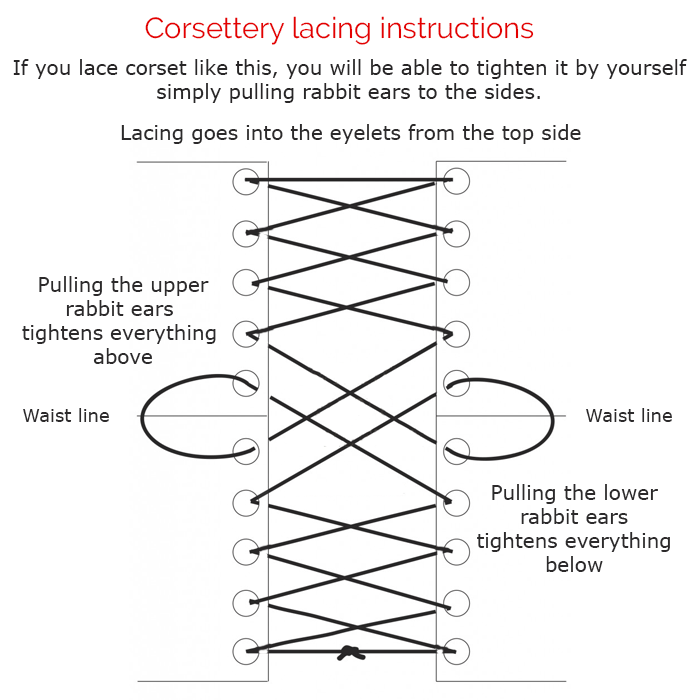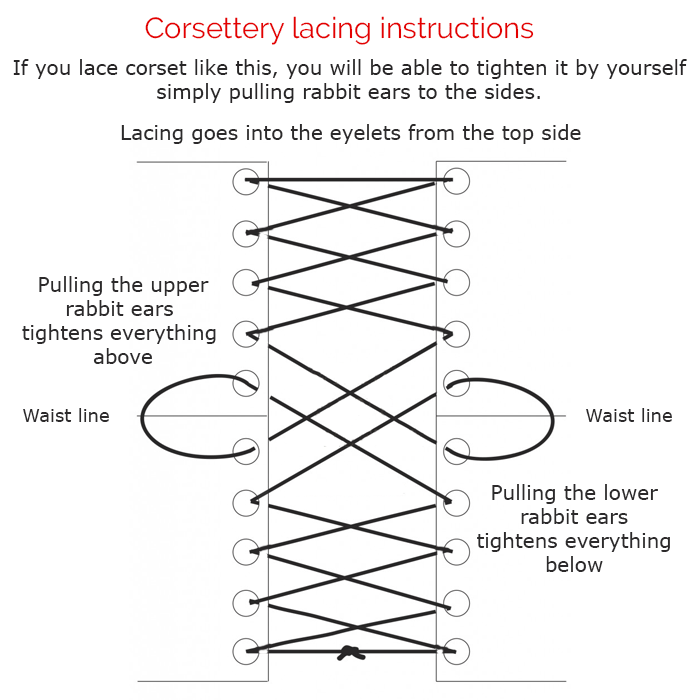Compra tus batidos entre semana y obtén los del fin de semana gratis. (¡7 por el precio de 5!)

Hay muchas maneras de atar tu nuevo corsé. Te ofreceremos algunos de ellos y explicaremos las ventajas y desventajas de cada uno. Nuestra guía ayudará incluso a principiantes completos y solo te tomará un poco de tiempo decidir cómo quieres atar la cinta de tu corsé. Hay una forma que es más cómoda para ajustar el corsé por ti mismo o formas que son adecuadas si puedes pedir ayuda a alguien.
Compra los cordones del corsé aquí.
Hay una cinta de corsé dura especial incluida con cada uno de nuestros corsés. Pero puedes comprar otra cinta si deseas tener una cinta de satén del mismo color que tu corsé. Solo recuerda que las cintas de satén delgadas que se venden en cada tienda de telas solo se pueden usar para ajustar tu corsé una o dos veces y serán adecuadas si la usas en ocasiones especiales o en una boda. Nuestra cinta de corsé con cordones es mucho más firme y fue diseñada especialmente para proporcionar un verdadero ajuste de authentic corset. Por favor, recuerda que solo necesitas un largo trozo de cinta para atar el corsé, no lo cortes en dos piezas.
Compra cordones (cuerdas) para tu corsé auténtico.
Formas de atar tu corsé
Primera forma de atar que es adecuada para personas que desean ajustar su corsé por sí mismas.

- coloca tu corsé frente a ti en la mesa. Parte superior (donde están las etiquetas) arriba y parte inferior (donde algunos corsés pueden tener bucles especiales para los sujetadores de medias) abajo.
- encuentra el medio de tu cordón de encaje.
- comience a enhebrar el corsé desde arriba, dejando casi 2-3 pulgadas entre las dos partes del corsé, dejando el medio del cordón de enhebrado entre los agujeros superiores.
- comience a enhebrar hacia abajo, alternando lados y agujeros hasta que llegue a la línea de la cintura (generalmente tiene cinta de cintura en el lado interior).
- este punto crea un gran lazo pasando el cordón hacia afuera y luego de regreso al mismo lado. Es probable que termines con un par de pies de cordón en cada lado. Continúa atando hasta que llegues al fondo del corsé.
- al final hay dos opciones que puedes elegir: atar los dos extremos del cordón juntos o hacer dos nudos en cada uno de los extremos.
- cuando empieces a apretar el corsé en ti mismo, tira de los lazos hacia los lados con ambas manos, esto ajustará tu corsé. Luego, haz un lazo cuando termines de apretar.
Esta forma de atar se verá así en corsé real.
Colección Completa De Corsés De Ajuste Fuerte
La segunda forma de atar los cordones es más complicada de ajustar por ti mismo y se recomienda si tienes a alguien que te ayude, pero se verá hermosa y bonita.

El resultado se verá así
Ver colección completa de Corsés Auténticos
También echa un vistazo a nuestro Corsés de Boda Guide.
Si estás buscando aprender a enhebrar y atar un corsé por ti mismo, ¡has venido al lugar correcto! Los corsés son una excelente manera de añadir un toque de estilo a cualquier atuendo, y aprender a enhebrarlos y atarlos tú mismo es una gran manera de ahorrar dinero y asegurarte de que tu corsé te quede perfectamente.
Antes de comenzar a atar tu corsé, necesitarás elegir la talla adecuada para ti. Tu corsé debe ajustarse cómodamente a tu cuerpo, pero no debe estar tan apretado que resulte incómodo o cause dolor. Una vez que tengas la talla correcta, ¡es hora de empezar a atar!
Para atar tu corsé, comienza pasando los cordones a través de los ojetes (pequeños agujeros o ojales) en la parte posterior del corsé. Asegúrate de que pases los cordones en la misma dirección en ambos lados. Una vez que hayas pasado los cordones a través de los ojetes, comienza a atarlos juntos en un nudo en la parte superior.
Una vez que tengas el nudo atado, comienza a tirar de los cordones para ajustarlos. Debes hacer esto gradualmente, asegurándote de tirar de los cordones de manera uniforme en ambos lados. A medida que tiras de los cordones, comenzarás a ver cómo el corsé toma forma. Cuando hayas tirado de los cordones tan ajustados como puedas, átalo en un lazo en la parte inferior.
Ahora que tu corsé está atado, es hora de ajustarlo. Comienza envolviendo los cordones alrededor de tu cintura, asegurándote de mantener los cordones parejos en ambos lados. Una vez que hayas envuelto los cordones alrededor de tu cintura, átalo en un lazo en la parte superior.
Finalmente, necesitarás ajustar los cordones para obtener el ajuste perfecto. Comienza aflojando los cordones en la parte superior, luego ajústalos gradualmente hasta que el corsé se ajuste cómodamente contra tu cuerpo. Cuando tengas el ajuste perfecto, ata los cordones en un lazo en la parte inferior.
¡Y ahí lo tienes! Ahora sabes cómo enhebrar y atar un corsé por ti mismo. Con un poco de práctica, podrás crear el corsé perfecto para cualquier atuendo.


















As someone who wears corsets both for fashion styling and waist support, I absolutely loved this post. I wear overbust corsets when dressing up for events, but I also wear a cotton underbust corset daily under my outfits for posture and waist training. I had no idea that using the wrong lacing method could actually reduce the effectiveness of a corset or damage it over time.
This post helped me switch to a proper lacing method that not only looks neater but also preserves the shape of my corset longer. Especially for tight-lacing, even tension and secure loops are everything. It’s amazing how much better my corsets fit now, just because I learned the right way to lace them. Corsettery’s commitment to education makes them stand out so much in the corset community.
I wish I had seen this when I first started with corsets! I completely messed up my first satin corset by lacing it too tight at the top and not tightening from the waistline. I thought the discomfort was normal — turns out, I just didn’t know how to lace a corset properly. This article explains everything in such a beginner-friendly way.
I tried the bunny ear method you recommended, and the difference is incredible. Now I can wear my underbust corset from Corsettery for hours without feeling like I’m being squished in all the wrong places. The visuals and breakdowns of each technique really helped me understand what’s best for different corset styles.
Thank you for making waist training less intimidating!
Corsettery never disappoints when it comes to educating their audience. This article helped me finally understand the subtle differences between straight lacing, spiral lacing, and inverted bunny ears. I always thought lacing was just aesthetic, but now I realize how critical it is to get the right lacing technique for comfort, safety, and proper waist training.
I own several Corsettery corsets — leather, velvet, and mesh — and each one responds slightly differently to lacing. This guide gave me the confidence to adjust each one appropriately depending on the material and how tight I want to lace for the day. Honestly, it’s this kind of support and information that keeps me loyal to Corsettery. It’s more than just buying a corset — it’s learning how to wear it the right way.
This is by far one of the best guides I’ve read about how to properly lace a corset! I’ve owned corsets before, but no one ever explained the importance of lacing technique the way this post does. I recently purchased a real steel-boned underbust corset from Corsettery for waist training, and this guide completely changed the way I wear it. After switching to the bunny ears lacing method, I noticed how much more evenly the pressure distributes — no more sore ribs or uneven compression.
I also appreciate the advice on loosening the corset properly before taking it off. That’s such an overlooked tip but crucial for protecting the integrity of the fabric and boning. This blog post isn’t just educational — it’s a must-read for anyone serious about tight-lacing or wearing corsets long-term.
I’ve been tight-lacing for several years, and one thing I always tell people is this: the lacing technique matters as much as the corset itself. This guide covers that so well. Whether you’re into gothic, burlesque, or daily waist training, proper lacing will protect your corset and your body. Corsettery is one of the few brands that makes real double-steel boned corsets that can handle actual training, and this guide proves they really know what they’re doing.